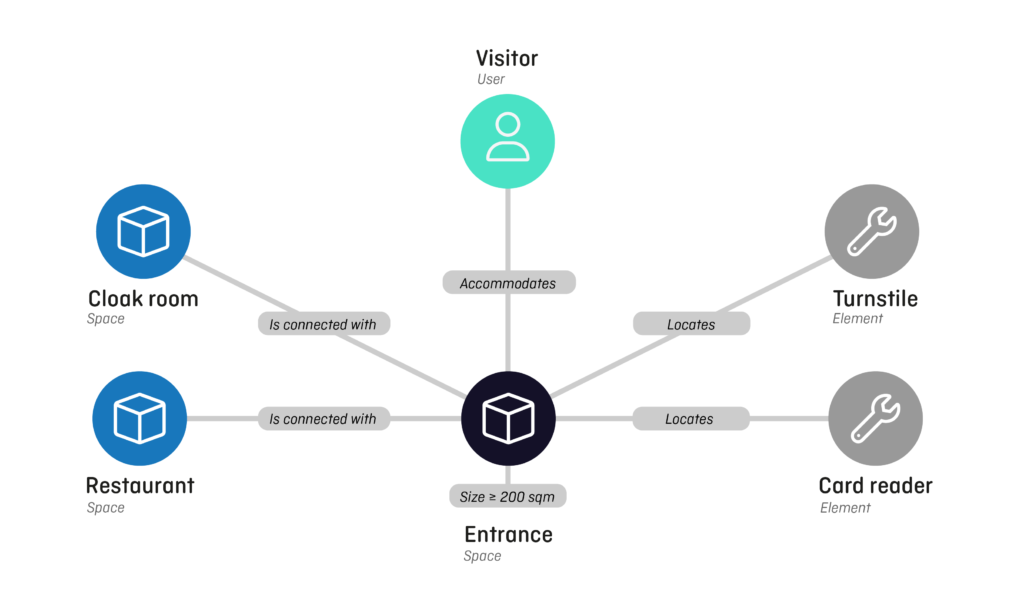
Anforderungen werden klassischerweise in umfangreichen PDF-Dokumenten festgehalten – und zwar stapelweise. Wir bei BriefBuilder gehen einen anderen Weg: Wir arbeiten mit einem modellbasierten Ansatz. Klingt irgendwie technisch? Keine Sorge – ist es nicht. Zumindest nicht sehr. Wir erklären es Dir.
Text und Modell im Vergleich
Die AEC-Branche befindet sich mitten in einer digitalen Transformation, in der künstliche Intelligenz, Robotik und Generatives Design die Arbeitsweise von Architekten, Ingenieuren und Bauunternehmern radikal verändern. Auf der Seite der Bauherren tut sich jedoch erstaunlich wenig, insbesondere bei der Entwicklung von Bedarfsplänen. Bei den meisten Projekten erfassen Bauherren ihre Anforderungen nach wie vor in umfangreichen Textdokumenten – viel geändert hat sich dabei in den letzten Jahrzehnten nicht.
Das Problem mit diesen Dokumenten ist, dass sie häufig suboptimal strukturiert sind und mit den Inhalten nicht unmittelbar weitergearbeitet werden kann. In einer PDF eingebettete Anforderungen können nicht in BIM-Modelle integriert, systematisch verifiziert oder auf Vollständigkeit geprüft werden. Wenn Anforderungen wiederverwendet werden sollen, können sie maximal von einem Dokument ins nächste kopiert werden – aber das geht smarter.
Wir haben eine Alternative entwickelt, mit der Du Anforderungen in einem integrierten Anforderungsmodell sammeln kannst. Wir zeigen Dir an einem einfachen Beispiel, wie das in der Praxis funktioniert.
In einem typischen Raumprogramm findest Du Sätze wie:
“„Der Besuchereingang sollte mindestens 200 m² groß sein. Der Bereich sollte mit dem Restaurant und der Garderobe verbunden sein und Drehkreuze sowie Kartenlesegeräte beinhalten.“”
Das sind nur zwei Sätze, die aber randvoll mit Anforderungen sind. Die Grundidee einer modellbasierten Herangehensweise ist, die einzelnen Anforderungen zu schärfen. Dafür werden Objekte (Besuchereingang), Objekte (Größe des Eingangs) und Relationen zu anderen Objekten (in diesem Fall zum Restaurant, der Garderobe, Drehkreuzen und Kartenlesegeräten) erstellt. Siehe Grafik unten.

Oben siehst Du in Diagrammform, wie Informationen erfasst werden. In der Benutzeroberfläche von BriefBuilder wählst Du einfach die relevanten Objekte und füllst die entsprechenden Felder aus.
Der größte Vorteil einer solchen modellbasierten Herangehensweise ist die sofortige Nutzbarkeit der Anforderungen: Auf diese Weise lassen sie sich leichter analysieren, verifizieren und wiederverwenden. Ein weiteres, praktisches Plus ist, dass die Anforderungen auf unterschiedliche Weise dargestellt werden können: in Raumbüchern, Excel-ähnlichen Übersichten oder sogar Nachbarschaftsdiagrammen. All das auf Basis desselben Datensatzes. Der Ansatz ermöglicht Dir auch, Anforderungen mit anderen Anwendungen auszutauschen und letztendlich bringt er den Bauherren dazu, möglichst genau und explizit auszuformulieren, was sie sich erwarten.
Unten stellen wir Dir die drei Hauptbausteine in BriefBuilder genauer vor:
- Objekte
- Eigenschaften
- Relationen
Objekte
Ein Objekt kann als „Einheit“ mit ganz bestimmten Eigenschaften betrachtet werden. Offensichtliche Beispiele sind physische oder räumliche Objekte wie Wände oder Räume, aber auch die Benutzer des Gebäudes und deren Abläufe können als Objekte betrachtet werden. In BriefBuilder gibt es unterschiedliche Objekttypen, die alle Anforderungen aufweisen können. Einige der wichtigsten sind:
- Standort: Geografischer Bereich oder Ort, an dem sich ein Gebäude befindet oder realisiert werden soll.
- Verbindung: Infrastrukturelle Verbindung zwischen zwei Punkten, z. B. Straßen, Schienen oder Kabeltrassen.
- Raum: Raum oder Bereich in- oder außerhalb eines Gebäudes, z. B. Maschinen- oder Meetingräume.
- System: Gruppe von Elementen, die einem gemeinsamen Zweck dienen, z. B. Belüftungssysteme.
- Element: Spezifische technische Einheit mit Standort, z. B. Steckdosen, Ampeln oder Straßenschilder.
- Benutzer: Stakeholder oder Personen, die das fertiggestellte Gebäude benutzen werden, z. B. Bewohner oder Betriebspersonal.
- Prozess: Spezifische Aktion, die vom Subunternehmer durchgeführt werden muss, z. B. Abrissarbeiten.
- Dienstleistung: Service, der während der Nutzungsphase zur Verfügung gestellt werden muss, z. B. Reinigung oder Instandhaltung.
Dies ist nur eine Auswahl von Objekttypen, gibt Dir aber schon mal einen guten Überblick darüber, wie viele unterschiedliche Objekte in BriefBuilder erfasst werden können.
Eigenschaften
Eigenschaften sind Charakteristika oder intrinsische Qualitäten eines Objekts. Ein Raum kann beispielsweise Eigenschaften wie Größe, Höhe oder Ambiente haben. Und ein Element kann z. B. Recyclingfähigkeit oder Fassungsvermögen als Eigenschaften aufweisen. In BriefBuilder kannst Du Deine Eigenschaften anhand der folgenden Attribute selbst definieren:
- Name: Name der Eigenschaft, also beispielsweise „Energieverbrauch“ oder „Grundfläche“.
- Beschreibung: Definition, was die Eigenschaft genau umfasst bzw. relevanter Standard (z. B. ISO-Norm).
- Komparator: Symbol (>, <, =, etc.), das definiert, ob es sich z. B. um eine Mindest- oder Maximalanforderung handelt.
- Wert: Benötigter Wert der Eigenschaft, entweder quantitativ (z. B. 30 m²) oder qualitativ (z. B. „leicht zu reinigen“).
- Maßeinheit: Einheit, in welcher der Wert angegeben wird, also etwa Quadratmeter.
Indem Du diese Attribute nutzt, formulierst Du Deine Anforderungen so klar und eindeutig wie möglich. Auf diese Art lassen sich Anforderungen außerdem auch „maschinell auswerten“.
Relationen
Der letzte Baustein eines modellbasierten Ansatzes sind die Bezüge zwischen Objekten – also sozusagen, wie alles miteinander zusammenhängen soll. Einige der wichtigsten Typen sind:
- Relationen in Bezug auf den Aufbau: Bestimme die Zusammenhänge zwischen Objekten und deren Teilen, zum Beispiel, dass eine Straße insgesamt aus zwei Fahrstreifen für KFZ und einem Fahrradstreifen bestehen soll.
- Relationen zum Ort: Lege fest, welche Elemente in einem Raum vorhanden sein sollten, wie beispielsweise eine Präsentationsleinwand im Meetingraum.
- Relationen zur Kapazität: Gib an, wie viele Personen in einem Raum unterkommen sollen, zum Beispiel sollte ein Klassenraum 25 Schüler aufnehmen können.
- Relationen von Schnittstellen: Erläutere, wie technische Systeme miteinander zusammenhängen, etwa das Gebäudemanagement- und Belüftungssystem.
- Relationen der Lage von Räumen: Bestimme, wie die Räume zueinander gelegen sein sollten, also zum Beispiel, dass die Garderobe in der Nähe des Eingangs zu finden sein soll.
In manchen Fällen können Relationen auch Attribute wie Anzahl oder Entfernung aufweisen. Bei der Festlegung der Relation bezüglich der Entfernung zwischen zwei Räumen kann zum Beispiel als Attribut festgelegt werden, dass die maximale Distanz 25 Meter betragen sollte.
Zusammengefasst
In BriefBuilder hältst Du Deine Anforderungen nicht in Textform fest, sondern in einem Online-Modell, das aus Objekten, Eigenschaften und Relationen besteht. Anstatt endlos langer und fragwürdig formulierter Texte bekommst Du glasklare Anforderungen in einem digitalen Format. Das hilft Bauherren, bessere Bedarfspläne zu entwickeln und bietet mehr Möglichkeiten, die Anforderungen in den Entwurfs- und Planungsprozess zu integrieren. Das Risiko für Entwurfsmängel und Qualitätsprobleme sinkt.
